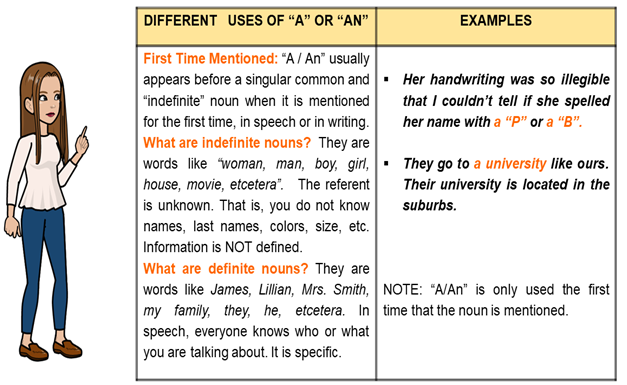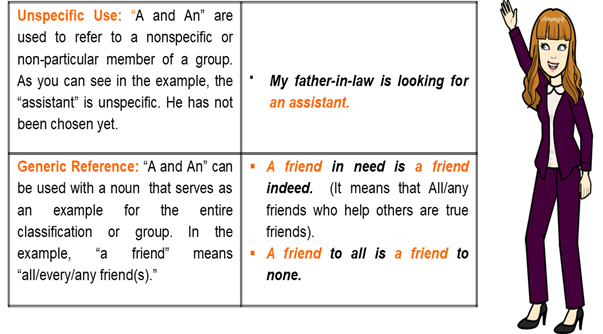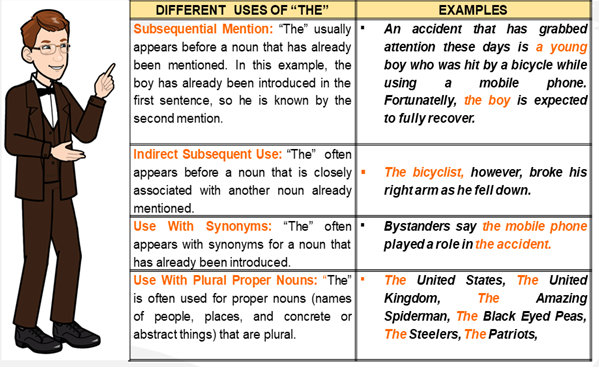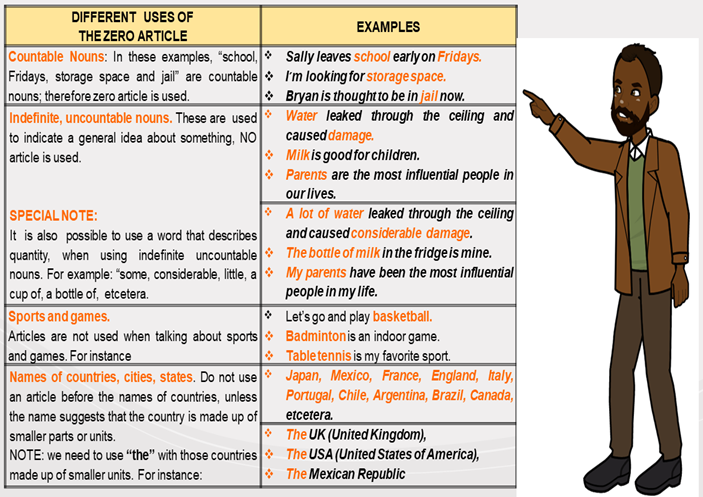I. WHAT ARE ARTICLES?
They are the following three words, which always come before a countable or an uncountable noun: ”a”, “an” “the”.
II. LET´S HAVE A PEEK AT LANGUAGE
Before we get started, it is important to remember that a

noun is “uncountable” if you cannot count it. For example, in English, we cannot count the noun “harmony”. It is incorrect to say: one harmony, two harmonies. Instead, we might count units of harmony: a bit of harmony. Usually nouns like, help, input, education, happiness, bread, water, anger or sunshine are not countable. Instead of counting these nouns, we might count units of them with approximate measurements: a slice of bread/ two slices of bread.
III. USING “A” or “AN”
“A” and “AN” are indefinite articles. They are called “indefinite” because “a/an” are used before singular countable nouns that are undefined or not specifically known to the interlocutor or reader. Read the following examples in the Tables.


IV. USING “THE”
On the other hand, the definite article “THE” is used before nouns (people, places, things, ideas, concepts) that are perfectly known to both the interlocutor and/ or reader. Consequently, the noun must have already been introduced, mentioned or in some cases, assumed by the interlocutor/reader. Read the following examples in the Tables.

V. USING THE ZERO ARTICLE
There are many instances when articles (a,an,the) may be omitted. They are called the ZERO article. For example, articles can be omitted before an undefined uncountable noun or before plural countable nouns. Here are a few examples of when NOT to use an article for indefinite meaning. Read the following examples in the Tables.

VI. CONSOLIDATION
VII. EXERCISE I.
VIII. READING TEXT.
READING COMPREHENSION AND VOCABULARY BUILDING

IX. EXERCISE 1.
X. BIBLIOGRAPHY.
Azar, B. S., Azar, D.A., & Koch R.S. (2009). Understanding and Using English Grammar. Longman.
Barker C. and Mitchell, L. (2004). Mega 1 (First Ed.). Macmillan Publishers.
Biber, D., Conrad, S., & Leech, G. (2007). Student grammar of spoken and written English. Essex, England: Pearson Education.
Hewings, M. (2013) Advanced Grammar in Use with Answers: A Self-Study Reference and Practice Book for Advanced Learners of English. CUP
Murray, L. (2014) English Grammar. Cambridge University Press.
XI. WEB RESOURCES.
Images 1 & 2 _ Personal subscription to Pixton
Reading Text_Review_Retrieved and adapted from: https://en.wikipedia.org/wiki/Battle_Hymn_of_the_Tiger_Mother
XII. REFERENCES.
Charts_Own source .
Image in Chart 1_ https://www.freepik.com/free-vector/smiling-boys-girls-pointing-banners-blank-empty-posters-sheets-paper-with-copy-space-set_22655987.htm#query=cute%20characters&position=40&from_view=keyword
XIII. CREDITS.
- (2021) Practice exercise written by Connie Reyes_Language Department at ENES-LEON UNAM
- Audio version performed by Sally and Matthew_Voicemker_Text to Speech Converter_Connie Reyes 2022 Subscription